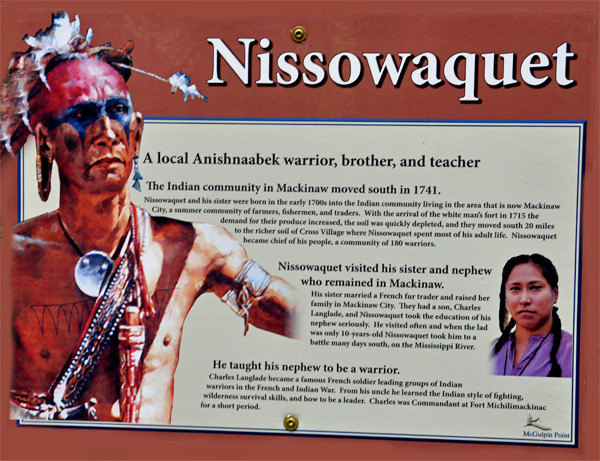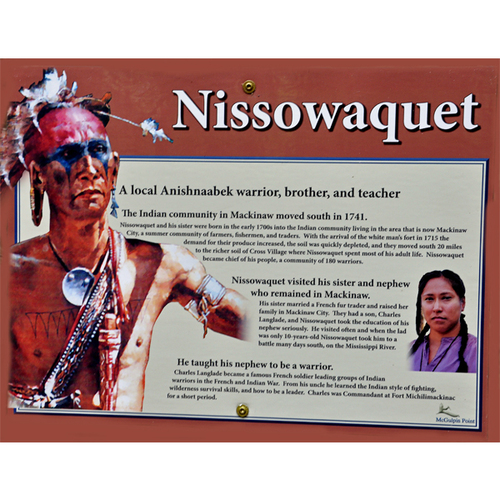
Source: Link
NISSOWAQUET (Nosawaguet, Sosawaket, La Fourche, Fork), Ottawa chief; the name apparently comes from Nassauaketon, meaning forked river, the designation of one of the four Ottawa bands; b. c. 1715; d. 1797.
Nissowaquet was born into the Nassauaketon band, whose village was located beside Fort Michilimackinac (Mackinaw City, Mich.). In 1741, having exhausted the soil there, these Ottawas moved to L’Arbre Croche (Cross Village, Mich.), 20 miles away. Their new settlement, which numbered approximately 180 warriors, stretched for several miles along the Lake Michigan shore. Its inhabitants lived there from spring until fall, raising corn for their own needs and for trade with the French, who depended on it to provision their canoes. In the autumn they divided into family hunting bands and went southward to the valleys of the St Joseph and other rivers to hunt for furs during the winter and to make maple sugar in the spring.
Living in proximity to Fort Michilimackinac, the band developed ties with the French. Nissowaquet’s bond with his sister’s son, Charles-Michel Mouet de Langlade, particularly encouraged his friendship with them and his later association with the British. In 1739 the French raised a force of Ottawas to assist Pierre-Joseph Céloron* de Blainville on an expedition against the Chickasaws, who lived in the lower Mississippi valley. Nissowaquet was one of the war chiefs who participated.
There was much discontent among the Indians of the pays d’en haut during the 1740s, but Nissowaquet and his band maintained their alliance with the French. The band is said to have frustrated an intended uprising of western Indians in 1744 by reporting it to Paul-Joseph Le Moyne de Longueuil. When war broke out between the French and the British in the 1750s, Nissowaquet and his warriors went east with Langlade to fight. In August 1757 a party of 70 assisted Montcalm* in the capture of Fort William Henry (also called Fort George, now Lake George, N.Y.). When the warriors returned to L’Arbre Croche they carried with them not only the spoils of war but the feared smallpox. The results were devastating. Ottawa tradition records that “Lodge after lodge was totally vacated – nothing but the dead bodies lying here and there in their lodges – entire families being swept off with the ravages of this terrible disease.”
The British occupied Fort Michilimackinac in 1761, and Nissowaquet and his band accepted the new régime, as did Langlade. When in June 1763 the Ojibwas of Michilimackinac, organized by Minweweh*, captured the fort, Nissowaquet’s band rescued most of the surviving soldiers and traders, whom they took to L’Arbre Croche and protected for over a month. For his services Nissowaquet obtained from the refugees a large quantity of trade goods and a personal slave. Some of the supplies he used to ransom captives from the Ojibwas, but many of the goods remained in his own lodge. A group of Ottawas escorted the refugees to Montreal and promised General Gage, the military governor of the Montreal District, that they would be as good friends of the British as they had been of the French. The next year, when Nissowaquet attended Sir William Johnson’s peace conference at Niagara (near Youngstown, N.Y.), he promised allegiance to the British and received in return a chief’s commission and a medal.
In subsequent years Nissowaquet used these tokens of friendship to obtain presents of rum, tobacco, and clothing. Arguing that the chiefs of the Ottawas “take most of their time in serving the English, & keeping peace, among all the Nations,” he obtained supplies from the commandants of Michilimackinac, particularly Robert Rogers. He was, according to Indian agent Benjamin Roberts, “the richest Indian I ever Saw.” All this wealth, the treasured commission, and a wampum belt received from Gage were consumed in a house fire in 1767, but Nissowaquet immediately began seeking replacement of his losses.
During the winter of 1767–68, while Nissowaquet was wintering on the Grand River (Mich.), Rogers was charged with treason and confined at Michilimackinac. Rumours circulated that Nissowaquet, the “Great Chief of the Ottawas,” would help Rogers escape. When Nissowaquet returned with 40 of his warriors in the spring he was upset by Rogers’ confinement, but although the Ojibwa chiefs showed their distress by throwing their British flags into the lake, he and his band returned peacefully to L’Arbre Croche. He kept tensions alive, however, by reporting the discovery of tracks of a large number of Indians with war canoes. Nissowaquet again shrewdly used the threat of attack by other Indians to bolster his own value to the British, promising at a conference in August 1768 that “as Long as you remain here you and your Garrison Shall always Sleep in Saftey, that we will watch over you, And If any bad news is hered amongst any of the Villiages you shall be informed of it Immediately as we are a check to all the Nations, whose harts are not True to the English . . . .”
When the American revolution broke out, Nissowaquet sided with the British, and his warriors took part in several expeditions. By the 1780s his active career was nearly over, although he continued to be the most important chief of L’Arbre Croche. He and his band usually made several visits to Michilimackinac in the summer to receive presents and have their hoes and guns repaired by the fort’s blacksmith; he was there in 1791, 1792, and 1793. Some time in 1797 he died.
AN, Col., C11A, 77, ff.151, 156, 158, 160. Clements Library, Thomas Gage papers, supplementary accounts, William Lesley’s deposition, 18 Feb. 1764; Henry Bostwick and Ezekiel Solomon’s deposition, 25 April 1764; Frederick Spiesmacher, journal, 6 Dec. 1767 – 17 June 1768; John Askin’s blacksmith accounts, 1769; George Turnbull’s Indian expenses, 25 May 1770 – 25 Nov. 1772. Newberry Library (Chicago), mss coll., George Etherington to Charles Langlade, 16, 18 June, 14 July 1763. PAC, RG 10, A2, 26, pp.14967–15076. Bougainville, Adventure in wilderness (Hamilton), 126, 143, 150–51; “Journal” (A.-E. Gosselin), ANQ Rapport, 1923–24, 266–67, 272–73, 282, 287–88. [A. S. De Peyster], Miscellanies, by an officer (Dumfries, Scot., 1813), 31, 33; [2nd ed.], ed. J. W. De Peyster (2v. in 1, New York, 1888), xxxiv, xxxv. Henry, Travels and adventures. Johnson papers (Sullivan et al.), V, 714–15; VI, 348–49; X, 779–85; XI, 273–74; XII, 491–92. Michigan Pioneer Coll., X (1886), 406; XII (1887), 261–63. NYCD (O’Callaghan and Fernow), IX, 1053; X, 608. [Robert Rogers], “Rogers’s Michillimackinac journal,” ed. W. L. Clements, American Antiquarian Soc., Proc. (Worcester, Mass.), new ser., 28 (1918), 247–51, 253–55. Treason? at Michilimackinac: the proceedings of a general court martial held at Montreal in October 1768 for the trial of Major Robert Rogers, ed. D. A. Armour (Mackinac Island, Mich., 1967), 41. Wis., State Hist. Soc., Coll., I (1855), 43–48; III (1857), 198–99, 212–13; VII (1876), 125–26; XVII (1906), 372–75; XVIII (1908), 67–68, 253, 388, 390; XIX (1910), 2–3, 50–52, 153–54. A. J. Blackbird, History of the Ottawa and Chippewa Indians of Michigan . . . (Ypsilanti, Mich., 1887), 9–10. N. W. Caldwell, “The Chickasaw threat to French control of the Mississippi in the 1740’s,” Chronicles of Oklahoma (Oklahoma City), XVI (1938), 465–92.
Cite This Article
David A. Armour, “NISSOWAQUET (Nosawaguet, Sosawaket) (La Fourche, Fork),” in Dictionary of Canadian Biography, vol. 4, University of Toronto/Université Laval, 2003–, accessed January 1, 2026, https://www.biographi.ca/en/bio/nissowaquet_4E.html.
The citation above shows the format for footnotes and endnotes according to the Chicago manual of style (16th edition). Information to be used in other citation formats:
| Permalink: | https://www.biographi.ca/en/bio/nissowaquet_4E.html |
| Author of Article: | David A. Armour |
| Title of Article: | NISSOWAQUET (Nosawaguet, Sosawaket) (La Fourche, Fork) |
| Publication Name: | Dictionary of Canadian Biography, vol. 4 |
| Publisher: | University of Toronto/Université Laval |
| Year of publication: | 1979 |
| Year of revision: | 1979 |
| Access Date: | January 1, 2026 |



